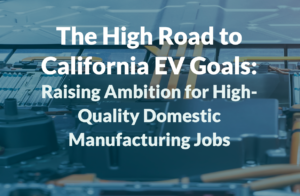The High Road to California EV Goals: Raising Ambition for High- Quality Domestic Manufacturing Jobs
In the words of President Joseph R. Biden, countries around the world are currently racing to win the future of electric vehicle (EV) and battery manufacturing. For U.S. workers and communities, the outcomes of this race may alternatively support family-sustaining jobs in a climate-resilient economy, or decimate auto and supply chain employment across whole economic regions. In California, EVs are a particular focus of state economic development and job growth efforts.
This report offers a unique contribution to the debates surrounding the role of high-quality jobs and domestic manufacturing in the EV transition. The industry forecasts and analyses herein show that, if structured appropriately, domestic manufacturing goals in the form of a domestic assembly Buy America policy would not be detrimental to state environmental goals. This report also finds that a Buy America incentive policy would create tens of thousands of high-road, high-quality manufacturing jobs in-state and in-country. This report, additionally, makes the following findings:
Significant Volumes and a Variety of Domestically-Assembled EVs Will Be Available in California by 2023
- 33 domestically-assembled battery electric vehicle (BEV) models are forecasted to be in commercial production by the end of 2023, including 27 new entrants rolled out between 2021 and 2023.
- Among domestically-assembled BEVs and plug-in hybrid vehicles (PHEVs) expected by 2023, 24 vehicles are expected to fall under the MSRP cap of $60,000 for California’s Clean Vehicle Rebate Program (CVRP). Total domestically-assembled BEVs eligible for CVRP will reach approximately 580,000 units by 2023, and 690,000 vehicles by 2025.
Domestic EV Production Will Significantly Exceed That Needed to Reach California EV Adoption Goals
- The California Air Resources Board (CARB) projects that to reach 1.5 million zero-emission vehicles (ZEV) on the road by 2025, 397,000 rebates will be required by 2025, or approximately 79,400 rebated vehicles per year.
- By 2023, domestic assemblers will greatly exceed this baseline demand. California rebate consumption would total only 14% of national PHEV/BEV sales.
Applying ‘Buy America’ Standards to California Incentives Would Create or Support 47,500 DomesticManufacturing Jobs Annually
- A domestic-assembly policy for California EV rebates would create or support approximately 6,250 U.S. vehicle assembly jobs each year, and 41,250 supplier jobs per year.
- Policies to incentivize the domestic production of vehicle content—including batteries and other critical electronics including software—would create and support even more U.S. jobs and ensure a secure supply chain.
- Paired with targeted hire policies, a Buy America standard would support access to high-road careers for low- income workers of color, dislocated workers from the fossil fuel industry, and other disadvantaged workers.
This report forecasts that the current trajectory of EV industry growth is consistent with policy goals to leverage up U.S. manufacturing and increase high-road EV jobs for disadvantaged workers. State vehicle and incentive policies can and must foster a domestic auto manufacturing sector capable of supporting a climate-resilient economy, while creating economic opportunities for disadvantaged workers and working-class communities.
Forecasting and industry analysis was provided by Alan Baum of Baum and Associates. Baum is Principal of Baum & Associates, an automotive consultancy in suburban Detroit with a focus on forecasting and analysis of the automotive industry, including trends in fuel economy and electric vehicles.
